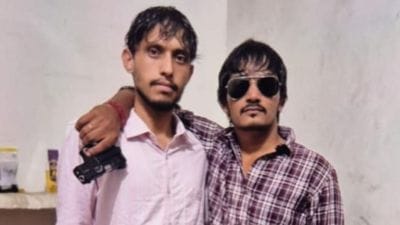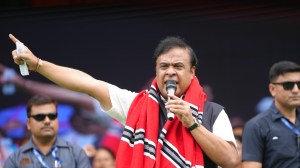After Sai Baba,what? His entire town is asking that question
There is a surreal feeling about the town of Puttaparthi,the birthplace of godman Sri Sathya Sai Baba
There is a surreal feeling about the town of Puttaparthi,the birthplace of godman Sri Sathya Sai Baba. Something sanitized,a distinct lack of the hum and buzz you normally associate with human enterprise. You can see this in the vacant gaze on the faces of so many people who busy around the town in spotless white in between their meditation sessions.
Once a sleepy hollow where the heat seared through the year and drained the small populace that lived off the earth,Puttaparthi is now the centre of a spiritual empire built around devotion to her most famous son Satyanarayana Raju aka Sri Sathya Sai Baba an empire that spans continents,an estimated 6 million devotees and riches cast in the range of Rs 40,000 crore.
As the 85-year-old Sai Baba battles the growing complications of mortality,this surreal feeling has only increased rumours of his death mix with prayers of devotees,with the anxieties of allied investors in the god business,and an unfolding boardroom style battle for stakes in the Sri Sathya Sai Central Trust,the all-powerful inheritor of Sai Babas legacy.
At sunset,over the past month,in the intermingling of the shadows cast by the rising apartments on what are still narrow village roads catering to the housing demand generated by Sai Babas Indian and foreign followers who abandon everything else in life for proximity to their guru there have been candlelight marches every time there has been bad news on Sai Babas health. With each alarming health bulletin,the town has come to a standstill,shops shuttered amid all-night bhajans.
As death casts its shadow over its spiritual bossman,there is a growing fear here that devoid of Baba and his devotees Puttaparthi could turn into a ghost town of empty apartments,unoccupied hotel rooms and palatial but unused buildings.
A lot of the future of Puttaparthi especially the humanitarian legacy of Sri Sathya Sai Babas mission the free medical treatment of the highest order without discrimination and the free education up to the university level would all depend on how the internal battles within the trust pan out after Sai Baba.
The 220-bed super speciality hospital in Puttaparthi spread over land donated by the Andhra Pradesh government was set up in 1992 by Sathya Sai Baba through funds donated to his trust by one of his ardent and high profile followers of several years,the American Isaac Burton Tigrett who founded the Hard Rock Cafe and House of Blues restaurant chains.
Hospitals,hospitality
The story goes that Sai Baba,in a talk in 1991,told devotees of his dream to set up a state-of-the-art hospital at Puttaparthi and Tigrett who was in the gathering offered to make it a reality.
Roping in the services of Keith Critchlow,renowned British architect and an expert in sacred architecture and geometry,Tigrett,now 64 and associated with Puttaparthis Prashanti Nilayam Ashram for nearly 40 years,used part of the funds from his Rama Foundation in Zurich where he had channelled half of the $108 million from the sale of the Hard Rock Cafe brand for the hospital project. And he was ble to deliver Babas dream within the one year given to him.
Ten years later in 2002,Sathya Sai Baba built his second super-speciality hospital to provide free treatment for all on a first-come-first-serve basis on 50 acres near his ashram at Whitefield in Bangalore,again with donations from far and wide. The two speciality hospitals were additions to a smaller general hospital of the trust at Puttaparthi.
All of Sai Babas hospitals have attracted some of the best doctor-devotees. Over the years,the hospitals have also spawned fantastic accounts of very poor people receiving the best of treatment. A vegetable vendor in Bangalores city market for instance had a heart surgery at Sai Babas hospital and donated Rs 130 the only money she had to his trust.
In 2002-03,the Sri Sathya Sai Central Trust was the single largest recipient of foreign donations in India,officially receiving Rs 95 crore. Till 2006,the trust at Puttaparthi figured in the list of top 15 foreign fund recipients in the country.
A series of incidents,including a 2004 BBC documentary called the Secret Swami which questioned the functioning of Sai Baba,including in the context of allegations of sexual deviancy and an incident of the killing of six young men at the Puttaparthi ashram in June 1993,seemed to have been setbacks to foreign fund flows to the trust.
In terms of assets,effectively half of Puttaparthi town in the form of an institute of higher learning,a cricket stadium,an indoor stadium,a musical institute,and a museum belong to the Sai Baba Central Trust,apart from the main ashram and two hospitals. Much of the land estimated to be in the range of over 1000 acres has been donated by the government and Sai Baba,in return,has funded the water supply for Puttaparthi town,222a rarity in the dry Anantapur region.
The Sri Sathya Sai Central Trust has as many 99 schools attached to it in India and a university off the Bangalore-Hyderabad highway. There are missions all over the world as well.
While the consolidated value of Sathya Sai Babas empire is estimated to be Rs 40,000 crore,people associated with the Sathya Sai Baba Central Trust claim that this is an exaggerated figure.
I dont know how the Rs 40,000 crore has been arrived at for the value of the assets of the trust. It is not as if the land held by the trust like the 50 acres in Bangalore can be converted into small plots of built up residential properties, says S S Naganand,a reputed advocate from Bangalore who is part of a four member council of management for the Sri Sathya Sai Trust.
The annual audited foreign contribution statements giving receipt and utilization are sent to the home ministry every year. The annual audited financial statements are also filed every year with various government agencies, he said.
The Trust After Sai Baba
Among the biggest pain points that seems to have emerged among Sai Baba devotees in the light of Sai Babas debilitating illness is fears of the misuse of assets of the trust by the members themselves and the possibility of members of Sai Babas family trying to wrest control over the trust in the aftermath of his death.
There is no way funds can be misused. All transactions of the trust are cheque transactions. Till July last year Baba would sign all cheques himself. He then handed over powers to trustees and the council of management. We cannot understand what all the talk about a succession plan is for a man who held nothing. It is the trust that has handled all affairs under Babas guidance, says council of management member Naganand.
There are still misgivings over the trust among the local devotees of Sai Baba who have often accuse it in recent years of keeping Sai Baba away from the public and controlling him to a large extent.
The Sri Sathya Sai Trust,incidentally,currently comprises of Justice P N. Bhagawati,former Chief Justice of India; Indulal Shah,a chartered accountant associated with the trust for over 40 years; S V Giri,former Central Vigilance Commissioner; V Srinivasan,former CII president and R J Rathnakar,Sai Babas nephew.
The council of management features J V Shetty,former Canara Bank chairman,T K K Bhagavat,former Indian Overseas Bank chairman,and K Chakravarthi,a retired IAS officer who was a district collector at Anantapur when Sai Babas mission was being built.
According to a joint statement issued by the trust since Sai Baba went into hospital and was declared critical on April 4,the trustees have diligently ensured that the funds of the trust are strictly utilized for the designated objects of the trust.
Faultlines in the family
Since the 2005 death of Sai Babas older brother Janakiraman,who strongly protected the interests of Sai Babas immediate family,his son Rathnakar,picked by Sai Baba himself,has been a lesser entity in the trust and is widely believed to have been ineffectual in protecting family interests until now.
Some of the fears of antagonism in the trust stem from the possibility of the family members of Sai Baba mostly unemployed nephews and nieces wanting to have a greater say in the affairs of the trust.
The family fears that Rathnakar will not be able to deliver a good deal for everybody, said Devaraman,a native of the old Puttaparthi village where Sai Baba was born.
No one or two individuals can take away any of the assets of the trust when all the affairs are managed by the trust, says council of management member Naganand.
The Andhra Pradesh government is meanwhile waiting and watching to see how things play out in the Sri Sathya Sai Trust after Sai Babas death.
The government has assured us that it has no interest in taking over the trust. This emerged in talks with finance secretary L V Subramanyam, says Naganand.
Still it is widely believed that the Andhra Pradesh government will move in at the slightest hint of anarchy to take over the trust and the legacy of Sai Baba. If the government has to take over the affairs of Sai Babas mission that could spell its end as well, says Shivanand Shetty a Sai Baba devotee in Puttaparthi.
Photos


- 01
- 02
- 03
- 04
- 05




























